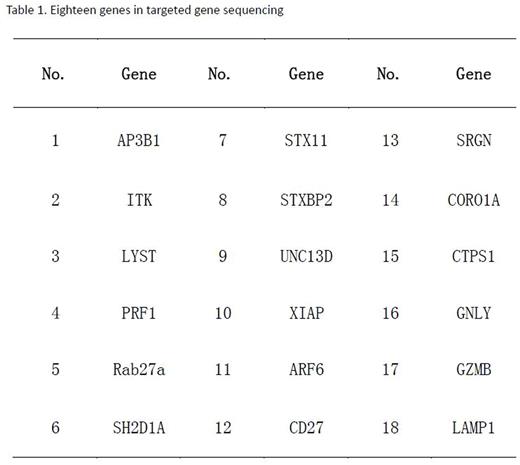Abstract
Introduction
Hemophagocytic lymphohistiocytosis (HLH) is characterized by overwhelming inflammatory cytokine storm. Patients with HLH usually present with fever, hepatosplenomegaly and cytopenia. Traditionally, HLH can be classified into primary and secondary HLH according to the underlying etiologies. Primary HLH is caused by genetic defects and always present in young children, while secondary HLH are mostly triggered extrinsic factors including infection, malignancy or autoimmune disease and always occur in adults.
Increasing evidence suggests that the distinction between primary HLH and secondary HLH may be less clear. HLH could be result of the combination of inherited genetic mutations, susceptibility loci and extrinsic triggers. Until now, it remains unclear whether adult patients have genetic mutations identified in pediatric cases.
Methods
We retrospectively included 103 adult cases of HLH in our study. Genomic DNA was isolated from peripheral blood. Target gene sequencing (TGS) of 18 genes that were reported to be associated with familial HLH was performed on Illumina Miseq or Nextseq platform, and the mean coverage was 1000 (Table 1). Bioinformatic analysis was carried out using standardized protocols. The variants at a frequency of 1% or more in normal East Asian populations were excluded from further analysis.
Results
Totally, 103 cases were analyzed in this study, which included 61 cases of malignancy-associated HLH, 21 infection-associated HLH, 3 autoimmune disease-associated HLH as well as 18 HLH with unknown origin.
Forty-three patients (41.7%) harbored mutations or variants in genes studied in the TGS panel. One case had homozygous mutation and two cases had compound heterozygous mutations. Three patients were double heterozygous. The remaining cases (37 of 43) carried only one mutated allele in one of these genes. Thirty eight mutations or rare variants were present in this cohort. Of these variants, seven variants were recurrently identified, including UNC13D p.G863D, ITK p.R581W, AP3B1 p.T310A, STXBP2 p.T163M, UNC13D p.R411Q, LYST p.H123R and STX11 p.F281C. UNC13D p.G863D were identified in two patients, including one patient with homozygous mutation. The allele frequency of UNC13D p.G863D in our cohort was higher than that in East Asian population (3/206[1.5%] vs 37/8638[0.4%], odds ratio[OR] 3.447, 95%CI 1.054-11.28; p=0.0651), although with only marginal significance. Recurrent ITK p.R581W mutation occurred in 4 cases, and the allele frequency of this mutation was also higher than that in normal East Asian population (4/206[2.0%] vs 70/8652[0.8%], OR 2.428, 95%CI 0.878-6.715; p=0.093), although not statistically significant. AP3B1 p.T359A occurred more frequently in our cohort as compared with normal East Asian population (2/206[1.0%] vs 2/8648[0.02%], OR 42.38, 95%CI 5.938-302.5; p=0.0031). STX11 p.F281C was also more frequent in our cohort (/206[0.97%] vs 1/8382[0.01%],OR 160.0; p=0.0005). There were no significant differences between our cohort and normal East Asians in the frequencies of the other three variants.
Conclusion
Our results suggest genetic defects are also involved in adult patients with HLH or secondary HLH, warranting genetic testing in these cases.
No relevant conflicts of interest to declare.
Author notes
Asterisk with author names denotes non-ASH members.


This feature is available to Subscribers Only
Sign In or Create an Account Close Modal